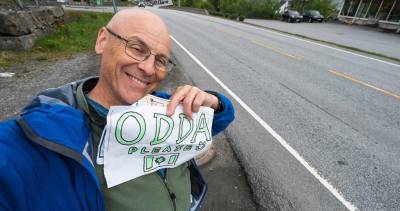Aerobatics with the Aeroshell Team at the Abbotsford Air Show
When the Pratt & Whitney radial engine of an AT-6 Texan comes to life, it’s a sound like no other. It’s a throaty roar—a growl, even—harking back to a simpler time, when piston engines were the order of the day and airspeed was measured in knots rather than mach numbers.
Earlier today, the Georgia Straight had the chance to take to the sky in a vintage Texan, with pilot Jimmy Fordham and the Aeroshell Aerobatic Team, as they practised manoeuvres for their upcoming appearances at the Abbotsford Air Show.
The 64-year-old Fordham—a soft-spoken southern gentleman who hails from Monroe, Louisiana—has been flying since he was 14 and has racked up more than 21,000 hours of flight time. With a steady pilot’s drawl and the indefinable laid-back nonchalance of a true stick-and-rudder man, Fordham is clearly a pro. He first soloed at the tender age of 16, got his commercial licence at 18, and was soon flying Lear jets as a corporate and charter pilot. He then moved on to Northwestern and Delta airlines, flying big jets like the Boeing 727, DC-10, and Airbus A330.
Now retired, he and the other Aeroshell team members fly all over North America for air shows. With appearances scheduled at 26 shows this year alone, it’s not difficult to see that it’s a labour of love for everyone involved.
“It’s so great to fly a piece of history,” Fordham says as we’re preparing for the flight. Showing off his plane—also known as Aeroshell #4—it’s easy to see that he’s both humbled by the plane’s past and happy to be a part of it.
“This Texan was built in Dallas, in 1943,” he explains, “and went on to serve in the Mexican Air Force from World War II until 1989.”
When North American Aviation began rolling out the Texans in 1938, it was the beginning of an incredible success story, with a huge number of Allied pilots in the Second World War earning their wings on the trusty warbird. In all, more than 15,000 were produced, with models serving Commonwealth countries known as the AT-6 Harvard. Many were licence-built in Canada by Noorduyn Aviation, as well as Canada Car and Foundry (makers of the Brill trolley buses that plied Vancouver streets until the mid-1980s). Texans were even used in combat and counterinsurgency roles by a number of nations, and for forward air control by the U.S. in Korea and Vietnam.
In many ways, both the beauty and the longevity of the AT-6 lay in its simple design. It is solidly built but not overpowered, giving it the strength and resilience needed for a good trainer. It’s a workhorse but easy to work on (with 95 to 98 percent of spare parts still available, according to Fordham), and it is responsive and fun to fly.
In other words, if the P-51 Mustang is the Cadillac of the sky, the Texan is perhaps more akin to the Checker Marathon—unbreakable, trustworthy, and with many models still working perfectly years in excess of their expiration date.
So what’s it like to fly with Fordham and the rest of the team? Well, there are few experiences that can match being a passenger in a 74-year-old warbird, flying in formation with three other planes. From beginning to end, the flight is absolutely exhilarating. Smooth, too—no doubt a result of Fordham’s considerable skill, but takeoff and landing is much more gentle than in a commercial airliner, and level flight is straight as an arrow.
When the aerobatics start, Fordham eases the plane into a full loop and you suddenly feel the force of 3.5 Gs (it’s not astronaut territory, but it still makes movement more difficult), then you’re over the top. Before you can catch your breath, however, you move into a barrel roll and then a wingover.
It’s a very odd sensation (not to mention slightly terrifying) to be inverted in the air, but when you’re in Fordham’s capable hands it never once feels unsafe. In fact, when you’re hanging upside-down at 1,300 feet, it’s easy to get a little philosophical and simply enjoy the feeling so eloquently expressed by John Gillespie Magee, Jr. in his sonnet High Flight:
Oh! I have slipped the surly bonds of earth,
And danced the skies on laughter-silvered wings
… And, while with silent lifting mind I’ve trod
The high untrespassed sanctity of space,
Put out my hand, and touched the face of God.
Fordham, obviously, lives with the feeling every time he flies.
“Aviation has been good to me,” he says. “I’ve been blessed to do it.”















Comments